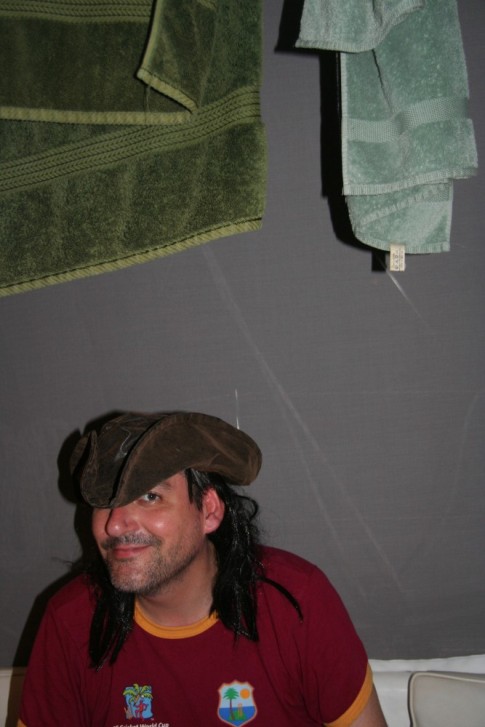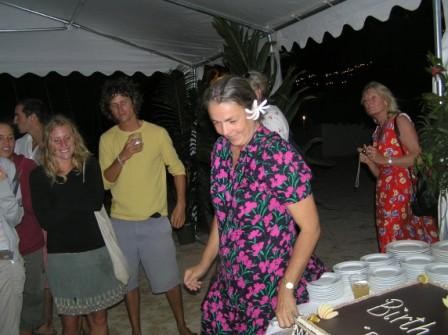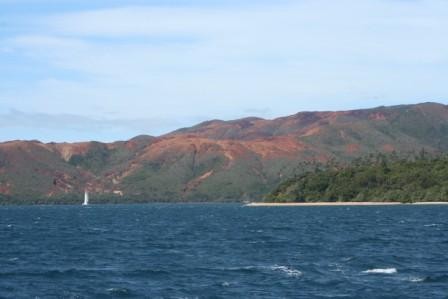
Around the World
23 February 2013 | Similan Islands Thailand
21 February 2013 | Bay of Bengal
15 February 2013 | Cinque Islands
15 February 2013 | Henry Lawrence Island
12 February 2013 | North Button Island
10 February 2013 | Henry Lawrence Island
09 February 2013 | Havelock Island
06 February 2013 | Neil Island
04 February 2013 | Rutland Island
01 February 2013 | Andaman Sea
30 January 2013 | Port Blair
26 January 2013 | Andaman Sea
26 January 2013 | Andaman Sea
03 December 2012 | Burma
02 December 2012
08 November 2012
08 November 2012 | Thailand
08 November 2012
10 June 2012 | Rebak Marina Langkawi
06 February 2012 | Malaysia
Lost in the Paddy Fields
04 February 2010 | Ping An
Michael and Jackie
Ping An is high in the mountains about three hours by road North of Guilin. This area is noted for what the Chinese Government calls "minority groups". The terrain is difficult, and in the most part the soil is porous, so the Han were not that interested in invading these areas. However, in the area around Ping An in the indigenous people discovered that the mountainous clay soil held water well, and was ideal for rice growing. Over a thousand years ago they therefore began a process of terracing the mountains. The whole countryside is layered with serpentine terraces. The Chinese tend to refer to them in terms of dragons. The dramatic effects, particularly when the rice is first green, and then yellow at harvest time are celebrated in countless photos. Colour effects particularly at sunrise and sunset are particularly stunning. We know this because we stayed at a small hotel owned by a famous Chinese photographer. What the guide books don't tell you is that for on average 248 days a year the famed rice terraces are shrouded in mist! Sadly our three days were noted by occasional exultant shouts of "I can see a terrace" ie visibility of more than 10 metres.
The Dong people who live in the area are famed for their long hair. All Chinese will tell you must see the long-haired people. In fact there are more than four different groups of longhair people. The common factor is that the woman, mostly about 4.5 feet tall, don't cut their hair until an event such as a wedding. Theoretically the first person to see their hair is their husband. However, this doesn't seem to stop lots of charming, smiling women of all ages offering to show you their hair, for a small fee. Paid for photo opportunities abound.
You ascend to the village, up a narrow spectacular hair-pinning road. As you slowly make your way up the gorge, past the debris of car and motorbike crashes, the style of housing changes. Instead of the typical Chinese village houses, mud brick generally replaced by brick and concrete, these houses are larger timber constructions. The Dong people like wooden houses. They can be easily moved and expanded. The houses are built rather in the manner of pole barns. Large poles are held vertical, and in place by diagonal bamboo poles. Typically the house is built over a precipice and it is simply the weight of the construction, plus the diagonal bamboos that hold the house in place. The whole house is pre-planned by the master carpenter on small bamboo splits, then constructed full size, traditionally without the use of nails.
The lower floor normally has animals, out of the darkness you can often hear the plaintive calls of the resident pig. The first floor is where the family lives. We were invited into one house. The family had built the house over their terraces, rather than in the village, in traditional style. Downstairs a women was making rice wine for the New Year. Upstairs, there was a large living area, pretty bare of furniture, except on one wall as a centre piece, an electronic display of time and temperature, next to a normal clock. Off the living area there were smaller sleeping areas. The house had electricity for the display, and a satellite TV, no other purpose.
To get to Pin. in you get out at a carpark, it is then a 30 minute climb up to the village. The village is being transformed by the new invaders, Chinese, and to a lesser extent Western, tourism. New buildings are being flung up everywhere. Hotels and lodges some built traditionally, but concrete pillars and the use of nails are creeping in. Shops and restaurants were busily preparing for the next tourist season.
We hiked to one of the famous viewpoints along the terraces. All the work on the terraces is done by hand, they are often only one spade width. Horses and people carry goods to the villages. We arrived at the first viewpoint, and looked through the mist, but all that could be seen were a few local women selling souvenirs. We then walked on to the next viewpoint to find that a new road cut through the path, 30 feet below. Totally impassable. The following day we walked to a more remote village. This village is about three hours from the nearest road, at the moment. Villagers walk to Ping An to pick up supplies, beer mostly, and to sell souvenirs to tourists. The houses are in the same style, but closer together, hugging the sides of the mountain, but without the gloss.
The Dong people who live in the area are famed for their long hair. All Chinese will tell you must see the long-haired people. In fact there are more than four different groups of longhair people. The common factor is that the woman, mostly about 4.5 feet tall, don't cut their hair until an event such as a wedding. Theoretically the first person to see their hair is their husband. However, this doesn't seem to stop lots of charming, smiling women of all ages offering to show you their hair, for a small fee. Paid for photo opportunities abound.
You ascend to the village, up a narrow spectacular hair-pinning road. As you slowly make your way up the gorge, past the debris of car and motorbike crashes, the style of housing changes. Instead of the typical Chinese village houses, mud brick generally replaced by brick and concrete, these houses are larger timber constructions. The Dong people like wooden houses. They can be easily moved and expanded. The houses are built rather in the manner of pole barns. Large poles are held vertical, and in place by diagonal bamboo poles. Typically the house is built over a precipice and it is simply the weight of the construction, plus the diagonal bamboos that hold the house in place. The whole house is pre-planned by the master carpenter on small bamboo splits, then constructed full size, traditionally without the use of nails.
The lower floor normally has animals, out of the darkness you can often hear the plaintive calls of the resident pig. The first floor is where the family lives. We were invited into one house. The family had built the house over their terraces, rather than in the village, in traditional style. Downstairs a women was making rice wine for the New Year. Upstairs, there was a large living area, pretty bare of furniture, except on one wall as a centre piece, an electronic display of time and temperature, next to a normal clock. Off the living area there were smaller sleeping areas. The house had electricity for the display, and a satellite TV, no other purpose.
To get to Pin. in you get out at a carpark, it is then a 30 minute climb up to the village. The village is being transformed by the new invaders, Chinese, and to a lesser extent Western, tourism. New buildings are being flung up everywhere. Hotels and lodges some built traditionally, but concrete pillars and the use of nails are creeping in. Shops and restaurants were busily preparing for the next tourist season.
We hiked to one of the famous viewpoints along the terraces. All the work on the terraces is done by hand, they are often only one spade width. Horses and people carry goods to the villages. We arrived at the first viewpoint, and looked through the mist, but all that could be seen were a few local women selling souvenirs. We then walked on to the next viewpoint to find that a new road cut through the path, 30 feet below. Totally impassable. The following day we walked to a more remote village. This village is about three hours from the nearest road, at the moment. Villagers walk to Ping An to pick up supplies, beer mostly, and to sell souvenirs to tourists. The houses are in the same style, but closer together, hugging the sides of the mountain, but without the gloss.
Comments
| Vessel Name: | Lady Kay |
| Vessel Make/Model: | Lagoon 380 |
| Hailing Port: | Falmouth |
| Crew: | Michael & Jackie Chapman |
Blue Waters

Who: Michael & Jackie Chapman
Port: Falmouth




